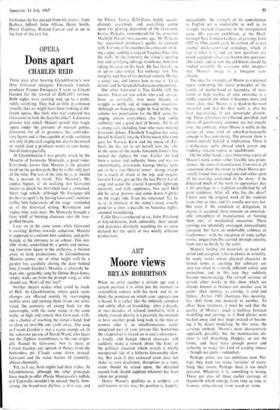Moore views
ART BRYAN ROBERTSON
When an artist reaches a certain age and a certain position it is often just the moment to re-establish contact with his work and to re- think the premises on which your appreciation is based. It is rather like the infinitely complex and subtle affair of friendship: after a decade, or two decades, of relaxed familiarity with a wholly trusted identity it is precisely the moment to have another good, long look at the man or woman who is an unselfconscious, easily integrated part of your private life. Sometimes the reappraisal is forced on to one's awareness: a kindly and benign liberal character will suddenly make a remark about 'the Jews or the political situation which reveals a wholly unexpected side of a hitherto foreseeable iden- tity. But even if this awkward event does not make its own disclosure, disruption as a tonic event should be seized upon, the detached second look should supplant whatever has been taken for granted.
Henry Moore's qualities as a sculptor are well known in this way; his position is, happily. unassailable; the strength of his contribution to English art is undeniable as well as its strongly marked eloquence in the international scene. His current exhibition, at the Marl- borough New London Gallery, of carvings from 1927 to 1966, could easily be written off as just another dealer-contrived anthology, which in fact is what it is, and yet new questions are posed, accepted values are thrown into question- able relief, and in sum the exhibition should be studied carefully by everyone who imagines that Moore's image is a foregone con- clusion.
The idea, for example, of Moore as a national figure enshrining the nicest principles of the family, of motherhood or fecundity, of reso- lution or high resolve, of stoic existence, is a mildly comical one when it becomes more and more clear that Moore is a dyed-in-the-wool surrealist and that his best work is also his least ingratiating, if not downright disturb- ing. These references to a blasted, petrified, and above all questioning anatomy are not exactly cosy; the contrary, when Moore is noble in the service of sonic kind of suburban-housewife concept is less convincing. The present show is almost entirely baleful in implication. There is a dislocatory spirit abroad which arrests any tendency toward repose or equilibrium.
On the other hand, a less interesting aspect of ,Moore's work conies rather forcibly into prom- inence: the sense of manufacture. I am not at all concerned about the extent to which Moore per- sonally found time to rough out and refine upon all the carvings contained in the show: if he delegated much of the work to apprentices that is his privilege in a tradition established by all great sculptors. After all, who has the ideas? I have seen the original work of his students from time to time, and it's usually not very hot. But even if the condition of delegation, in degree, is accepted, there remains an unmistak- able atmosphere of manufacture, of 'turning them out,' of mechanical execution. These carvings are splendidly envisaged, immaculately executed, but have an undeniable coldness or facelessness—with the exception of some earlier works, unquestionably carried through entirely, from start to finish, by the artist.
Moore's 'feeling' for materials, so much ad- mired and accepted, is his weakness in actuality. So many works whose physical character in formal terms is anything but arbitrary are seen too often in a totally different colour and patination; and in this way they suddenly become unconvincing. The carved versions of certain other works in this show which are already known as bronzes are another case in point : their identity, as carving, is cold and lifeless. Archer 1965 illustrates this meaning- less shift from one material to another. To offset these strictures, it must be said that the quality of Moore's touch is halfway between modelling and carving, as if fluid plaster were hacked away and into shape instead of becom- ing it by direct modelling. In this sense, the carvings embody Moore's most characteristic approach, possibly; but the manufacture ele- ment is still disturbing. Happily, so are the forms, and these have enough power and authority to make this kind of carping almost —though not quite—redundant.
Perhaps artists are too ambitious now. Per- haps they want too many 'versions' of every- thing they invent. Perhaps there is too much pressure. Whatever it is, something is wrong. There are also all those earlier carvings of Hepworth which emerge from time to time as bronzes, reincarnated from wood or stone.






























 Previous page
Previous page